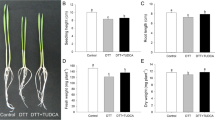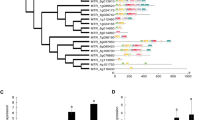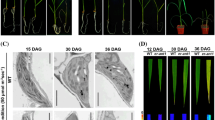Abstract
A small number of stress-responsive genes, such as those of the mitochondrial F1F0-ATP synthase complex, are encoded by both the nucleus and mitochondria. The regulatory mechanism of these joint products is mysterious. The expression of 6-kDa subunit (MtATP6), a relatively uncharacterized nucleus-encoded subunit of F0 part, was measured during salinity stress in salt-tolerant and salt-sensitive cultivated wheat genotypes, as well as in the wild wheat genotypes, Triticum and Aegilops using qRT-PCR. The MtATP6 expression was suddenly induced 3 h after NaCl treatment in all genotypes, indicating an early inducible stress-responsive behavior. Promoter analysis showed that the MtATP6 promoter includes cis-acting elements such as ABRE, MYC, MYB, GTLs, and W-boxes, suggesting a role for this gene in abscisic acid-mediated signaling, energy metabolism, and stress response. It seems that 6-kDa subunit, as an early response gene and nuclear regulatory factor, translocates to mitochondria and completes the F1F0-ATP synthase complex to enhance ATP production and maintain ion homeostasis under stress conditions. These communications between nucleus and mitochondria are required for inducing mitochondrial responses to stress pathways. Dual targeting of 6-kDa subunit may comprise as a mean of inter-organelle communication and save energy for the cell. Interestingly, MtATP6 showed higher and longer expression in the salt-tolerant wheat and the wild genotypes compared to the salt-sensitive genotype. Apparently, salt-sensitive genotypes have lower ATP production efficiency and weaker energy management than wild genotypes; a stress tolerance mechanism that has not been transferred to cultivated genotypes.


Similar content being viewed by others
Abbreviations
- MtATP6:
-
Mitochondrial F1F0-ATP synthase 6-kDa subunit
- qRT-PCR:
-
Quantitative reverse transcriptase polymerase chain reaction
- ABA:
-
Abscisic acid
- AREB/ABF:
-
ABA-responsive element binding/ABA-responsive element binding factor
- ABRE:
-
Abscisic acid response element
- MYC:
-
Myelocytomatosis oncogene cellular homolog
- MYB:
-
Myeloblastosis viral oncogene homolog
- W-boxes:
-
WRKY-binding sites
- CT :
-
Cycle threshold
- HKT:
-
High affinity potassium transporter
- SOS:
-
Salt overly sensitive
- DRE:
-
Dehydration-responsive element
- GTLs:
-
GT-element-binding proteins
- CBF/DREB:
-
C-repeat binding factor/Dehydration-responsive element binding protein
- AP2:
-
Apetala 2
- ROS:
-
Reactive oxygen species
- AOX:
-
Alternative oxidase
- ABI4:
-
Abscisic acid insensitive 4
References
Agarwal, B. (2011). A role for anions in ATP synthesis and its molecular mechanistic interpretation. Journal of Bioenergetics and Biomembranes, 43, 299–310.
Alkhani, H., & Ghorbani, M. (1993). A contribution to the halophytic vegetation and flora of Iran. In H. Lieth & A. Al Masoom (Eds.), Towards the Rational Use of High Salinity Tolerance Plants (Vol. 1, pp. 35–44). Dordrecht: Kluwer Academic Publishers.
Baena-González, E. (2010). Energy signaling in the regulation of gene expression during stress. Molecular Plant, 3, 300–313.
Bayer, J. S. (1982). Plant productivity and environment. Science, 218, 443–448.
Carrie, C., Giraud, E., & Whelan, J. (2009). Protein transport in organelles: dual targeting of proteins to mitochondria and chloroplasts. The Federation of European Biochemical Societies Journal, 276, 1187–1195.
Chandra, S. B., & Manatt, M. (2011). The effects of mitochondrial dysfunction in schizophrenia. The Journal of Medical Genetics and Genomics, 3, 84–89.
Colmer, T. D., Flowers, T. J., & Munns, R. (2006). Use of wild relatives to improve salt tolerance in wheat. The Journal of Experimental Botany, 57, 1059–1078.
Deihimi, T., Niazi, A., Ebrahimi, M., Kajbaf, K., Fanaee, S., Bakhtiarizadeh, M. R., et al. (2012). Finding the undiscovered roles of genes: an approach using mutual ranking of coexpressed 4 genes and promoter architecture-case study: Dual roles of thaumatin like proteins in biotic and abiotic stresses. SpringerPlus, 1, 30.
Dobrota, C. (2006). Energy dependant plant stress acclimation. Reviews in Environmental Science & Biotechnology, 5, 243–251.
Doğan, M. (2011). Antioxidative and proline potentials as a protective mechanism in soybean plants under salinity stress. African Journal of Biotechnology, 10, 5972–5978.
Escobar, M. A., Franklin, K. A., Svensson, A. S., Salter, M. G., hitelam, G. C., & Rasmusson, A. G. (2004). Light regulation of the Arabidopsis respiratory chain: multiple discrete photoreceptor responses contribute to induction of type II NAD(P)H dehydrogenase genes. Plant Physiology, 136, 2710–2721.
Eswaran, N., Parameswaran, S., Sathram, B., Anantharaman, B., Kumar, G. R. K., & Tangirala, S. J. (2010). Yeast functional screen to identify genetic determinants capable of conferring abiotic stress tolerance in Jatropha curcas. BMC Biotechnology, 10, 23.
Flowers, T. J. (2004). Improving crop salt tolerance. The Journal of Experimental Botany, 55, 307–319.
Galon, Y., Finkler, A., & Fromm, H. (2010). Calcium-regulated transcription in plants. Molecular Plant, 3, 653–669.
Gechev, T. S., Van Breusegem, F., Stone, J. M., Denev, I., & Laloi, C. (2006). Reactive oxygen species as signals that modulate plant stress responses and programmed cell death. BioEssays, 28, 1091–1101.
Ghavami, F., Malboobi, M. A., Ghannadha, M. R., Yazdi-Samadi, B., Mozaffari, J., & Jafar-Aghaei, M. (2004). Evaluation of salt tolerance of Iranian wheat genotypes at germination and seedling stages. Iranian Journal of Agricultural Sciences, 35, 453–464.
Giraud, E., Ho, L. H. M., Clifton, R., et al. (2008). The absence of alternative oxidase 1a in Arabidopsis thaliana results in acute sensitivity to combined light and drought stress. Plant Physiology, 147, 595–610.
Giraud, E., Van Aken, O., Ho, L. H. M., & Whelan, J. (2009). The transcription factor ABI4 is a regulator of mitochondrial retrograde expression of alternative oxidase 1a. Plant Physiology, 150, 1286–1296.
Gorham, J., Bristol, A., Young, E. M., & Wyn Jones, R. G. (1991). The presence of the enhanced K/Na discrimination trait in diploid Triticum species. Theoretical and Applied Genetics, 82, 729–736.
Gorham, L., Hardy, C., Wyn Jones, R. G., Joppa, L. R., & Law, C. N. (1987). Chromosomal location of a K+/Na+ discrimination character in the genome D of wheat. Theoretical and Applied Genetics, 74, 584–588.
Hamilton, C. A., Allin, G. G., & Gregory, J. T. (2001). Induction of vacuolar ATP synthase and mitochondrial ATP synthase by aluminum in an aluminum-resistant genotype of wheat. Plant Physiology, 125, 2068–2077.
Hasegawa, P. M., Bressan, R. A., Zhu, J. K., & Bohnert, H. J. (2000). Plant cellular and molecular responses to high salinity. Annual Review of Plant Physiology and Plant Molecular Biology, 51, 463–499.
Heise, A., Lippok, B., Kirsch, C., & Hahlbrock, K. (2002). Two immediate-early pathogen-responsive members of the AtCMPG gene family in Arabidopsis thaliana and the W-box-containing elicitor-response element of AtCMPG1. Proceedings of the National Academy of Sciences of the United States of America, 99, 9049–9054.
Jain, M., Nijhawan, A., Tyagi, A. K., & Khurana, J. P. (2006). Validation of housekeeping genes as internal control for studying gene expression in rice by quantitative real-time PCR. Biochemical and Biophysical Research, 345, 646–651.
Kong, Y., Zhou, G., & Wang, Y. (2001). Physiological characteristics and alternative respiratory pathway under salt stress in two wheat genotypes differing in salt tolerance. The Russian Journal of Plant Physiology, 48, 595–600.
Langridge, P., Paltridge, N., & Fincher, G. (2006). Functional genomics of abiotic stress tolerance in cereals. Briefings in Functional Genomics and Proteomics, 4, 34–354.
Larionov, A., Krause, A., & Miller, W. (2005). A standard curve based method for relative qRT-PCR data processing. BMC Bioinformatics, 6, 62.
Laus, M. N., Flagella, Z., Trono, D., Soccio, M., Fonzo, N. D., & Pastore, D. (2007). Sea water stress affects mitochondrial proline oxidation but not alternative oxidase activity in durum wheat germinating seedlings, Water Saving in Mediterranean Agriculture and Future Research Needs proceedings of the International Conference. Valenzano (Italy), 2, 98–108.
Lescot, M., Déhais, P., Thijs, G., et al. (2002). PlantCARE, a database of plant cis-acting regulatory elements and a portal to tools for in silico analysis of promoter sequences. Nucleic Acids Research, 30, 325–327.
Li, S., Fu, Q., Chen, L., Huang, W., & Yu, D. (2011). Arabidopsis thaliana WRKY25, WRKY26, and WRKY33 coordinate induction of plant thermo tolerance. Planta, 233, 1237–1252.
Meyer, E. H., Taylor, N. L., & Millar, A. H. (2008). Resolving and identifying protein components of plant mitochondrial respiratory complexes using three dimensions of gel electrophoresis. Journal of Proteome Research, 7, 786–794.
Michalecka, A. M., Svensson, A. S., Johansson, F. I., et al. (2003). Arabidopsis genes encoding mitochondrial type II NAD(P)H dehydrogenases have different evolutionary origin and show distinct responses to light. Plant Physiology, 133, 642–652.
Moghadam, A. A., Ebrahimie, E., Taghavi, S. M., Niazi, A., & Djavaheri, M. (2012). Isolation and in silico functional analysis of MtATP6, a 6-kDa subunit of mitochondrial F1F0-ATP synthase, in response to abiotic stress. Genetic and Molecular, 11, 3547–3567.
Munns, R., & Richards, R. A. (2007). Recent advances in breeding wheat for drought and salt stresses. In M. A. Jenks, et al. (Eds.), Advances in molecular breeding toward drought and salt tolerant crops (pp. 565–585). Berlin: Springer.
Naghavi, M. R., Aghaei, M. J., Taleei, A. R., Omidi, M., Mozafari, J., & Hassani, M. E. (2009). Genetic diversity of the D-genome in T. aestivum and Aegilops species using SSR markers. Genetic Resources and Crop Evolution, 56, 499–506.
Park, H. C., Kim, M. L., Kang, Y. H., et al. (2004). Pathogen- and NaCl-induced expression of the SCaM-4 promoter is mediated in part by a GT-1 box that interacts with a GT-1-like transcription factor. Plant Physiology, 135, 2150–2161.
Pastore, D., Trono, D., Laus, M. N., Di Fonzo, N., & Flagella, Z. (2007). Possible plant mitochondria involvement in cell adaptation to drought stress. A case study: Durum wheat mitochondria. The Journal of Experimental Botany, 58, 195–210.
Patnaik, D., & Khurana, P. (2001). Wheat biotechnology: A mini review. Electronic Journal of Biotechnology, 4, 0717–3458.
Priest, H. D., Filichkin, S. A., & Mockler, T. C. (2009). cis-Acting elements in plant cell signaling. Current Opinion in Plant Biology, 12, 643–649.
Ramezani, A., Niazi, A., Moghadam, A. A., Zamani, B. M., Deihimi, T., Ebrahimi, M., Akhtardanesh, H., & Ebrahimie, E. (2012) Quantitative expression analysis of TaSOS1 and TaSOS4 genes in cultivated and wild wheat plants under salt stress. Molecular Biotechnology. doi:10.1007/s12033-012-9513-z.
Raven, J. A. (1985). Regulation of pH and generation of osmolarity in vascular plants: A cost-benefit analysis in relation to efficiency of use of energy, nitrogen and water. New Phytologist, 101, 25–77.
Ryan, M. T., & Hoogenraad, N. J. (2007). Mitochondrial–nuclear communications. Annual Review Biochemistry, 76, 701–722.
Shah, S., Gorham, I., Forster, B. P., & Wyn Jones, R. G. (1987). Salt tolerance in the Triticeae: The contribution of the genome D to cation selectivity in hexaploid wheat. The Journal of Experimental Botany, 38, 254–269.
Shen, Q., Zhang, P., & Ho, T. H. (1996). Modular nature of abscisic acid (ABA) response complexes: composite promoter units that are necessary and sufficient for ABA induction of gene expression in barley. Plant Cell, 8, 1107–1119.
Shinozaki, K., & Yamaguchi-Shinozaki, K. (2007). Gene networks involved in drought stress response and tolerance. The Journal of Experimental Botany, 58, 221–227.
Soontharapirakkul, K., Promden, W., Yamada, N., et al. (2011). Halotolerant cyanobacterium aphanothece halophytica contains a Na+-dependent F1F0-ATP synthase with potential role in salt-stress tolerance. The Journal of Biological Chemistry, 286, 10169–10176.
Tahmasebi, A., Aram, F., Ebrahimi, M., Mohammadi-Dehcheshmeh, M., & Ebrahimie, E. (2012). Genome-wide analysis of cytosolic and chloroplastic isoforms of glutathione reductase in plant cells. Plant Omics Journal, 5, 94–102.
Tariq, M., Nazar, N., Haider, A. B., & Saqlan, N. S. M. (2010). Comparative analysis of regulatory elements in different germin-like protein gene promoters. African Journal of Biotechnology, 9, 1871–1881.
Türkoglu, N., Erez, M. E., & Battal, P. (2011). Determination of physiological responses on hyacinth (Hyacinthus orientalis) plant exposed to different salt concentrations. African Journal of Biotechnology, 10, 6045–6051.
Valkoun, J. J. (2001). Wheat pre-breeding using wild progenitors. Euphytica, 119, 17–23.
Van Aken, O., Giraud, E., Clifton, R., & Whelan, J. (2009). Alternative oxidase: A target and regulator of stress responses. Physiology Plant, 137, 354–361.
Veen, B. W. (1980). Energy cost on ion transport. Genetic engineering of osmoregulation. In D. W. Rains, R. C. Valentine, & A. Hollaender (Eds.), Impact on plant productivity for food, chemicals and energy (pp. 187–195). New York: Plenum.
Voigt, C., Oster, U., Börnke, F., et al. (2010). In-depth analysis of the distinctive effects of norflurazon implies that tetrapyrrole biosynthesis, organellar gene expression and ABA cooperate in the gun-type of plastid signaling. Physiology Plant, 138, 503–519.
Xie, Z., Zou, H., Lei, G., et al. (2009). Soybean trihelix transcription factors GmGT-2A and GmGT-2B improve plant tolerance to abiotic stresses in transgenic Arabidopsis. PLoS ONE, 4, e6898.
Yamaguchi-Shinozaki, K., & Shinozaki, K. (2005). Organization of cis-acting regulatory elements in osmotic- and cold-stress responsive promoters. Trends in Plant Science, 10, 88–94.
Yoo, C. Y., Jin, J. B., Miura, K., Jin, Y. H., Gosney, M., Mickelbart, M. V., Bressan, R. A., & Hasegawa, P. M. (2007). Ca2+/CaM signaling through AtGTL1 mediates drought stress adaptation. Botany and Plant Biology Joint Congress, July 7–11, Chicago, Illinois, USA.
Yu, B. S., & Sun, G. R. (1995). Preliminary study of several spring wheat varieties for resistance to Septoria diseases (Chinese). Crop Genetic Resources, 1, 27–29.
Zamani Babgohari, M., Niazi, A., Moghadam, A. A., Deihimi, T., & Ebrahimie, E. (2012). Genome-wide analysis of key salinity-tolerance transporters (HKTs) in wheat and wild wheat relatives (A and D genomes). In Vitro Cellular and Developmental Biology-Plant. doi:10.1007/s11627-012-9478-4.
Zhang, X. X., & Liu, S. K. (2003). Identification and characterization of mitochondrial ATP synthase small subunit gene in rice (Oryza sativa L.). Molecular Plant Breeding, 1, 605–612.
Zhang, X., Liu, S., & Takano, T. (2008). Overexpression of a mitochondrial ATP synthase small subunit gene (AtMtATP6) confers tolerance to several abiotic stresses in Saccharomyces cerevisiae and Arabidopsis thaliana. Biotechnology Letters, 30, 1289–1294.
Zhang, X., Takano, T., & Liu, S. K. (2006). Identification of a mitochondrial ATP synthase small subunit gene (RMtATP6) expressed in response to salts and osmotic stresses in rice (Oryza sativa L.). The Journal of Experimental Botany, 57, 193–200.
Zhou, D. X. (1999). Regulatory mechanism of plant gene transcription by GTLs and GT-factors. Trends Plant Science, 4, 210–214.
Acknowledgments
The authors would like to thank the Institute of Biotechnology for supporting this research and the Bioinformatics Research Group in the College of Agriculture (Shiraz University). We thank Dr. Mehrabi (Ilam University) for kindly supplying seeds of wild genotypes for this study. We thank Dr. Manijeh Mohammadi Dehcheshmah for his help in performing the qRT-PCR experiments.
Author information
Authors and Affiliations
Corresponding author
Electronic supplementary material
Below is the link to the electronic supplementary material.
Rights and permissions
About this article
Cite this article
Moghadam, A.A., Ebrahimie, E., Taghavi, S.M. et al. How the Nucleus and Mitochondria Communicate in Energy Production During Stress: Nuclear MtATP6, an Early-Stress Responsive Gene, Regulates the Mitochondrial F1F0-ATP Synthase Complex. Mol Biotechnol 54, 756–769 (2013). https://doi.org/10.1007/s12033-012-9624-6
Published:
Issue Date:
DOI: https://doi.org/10.1007/s12033-012-9624-6




